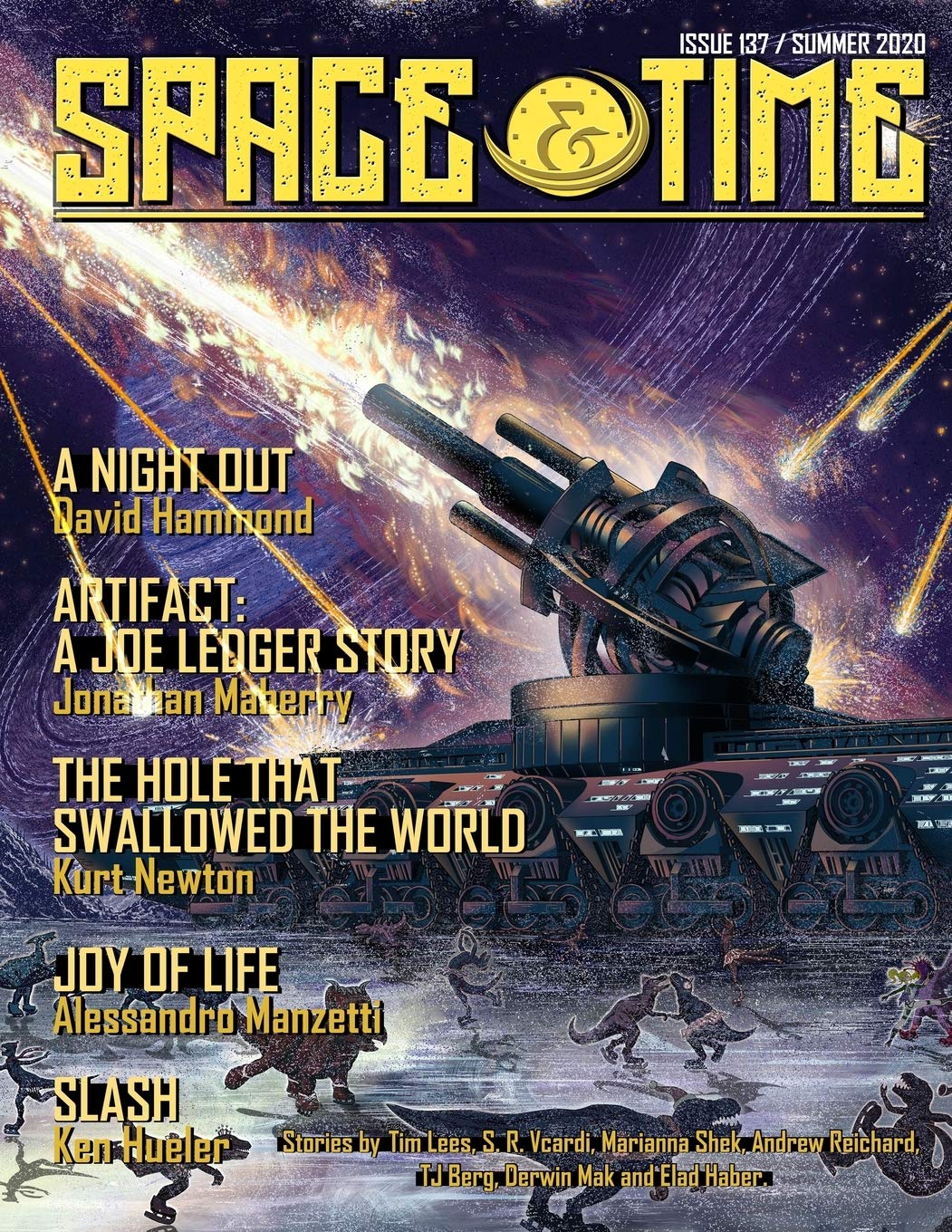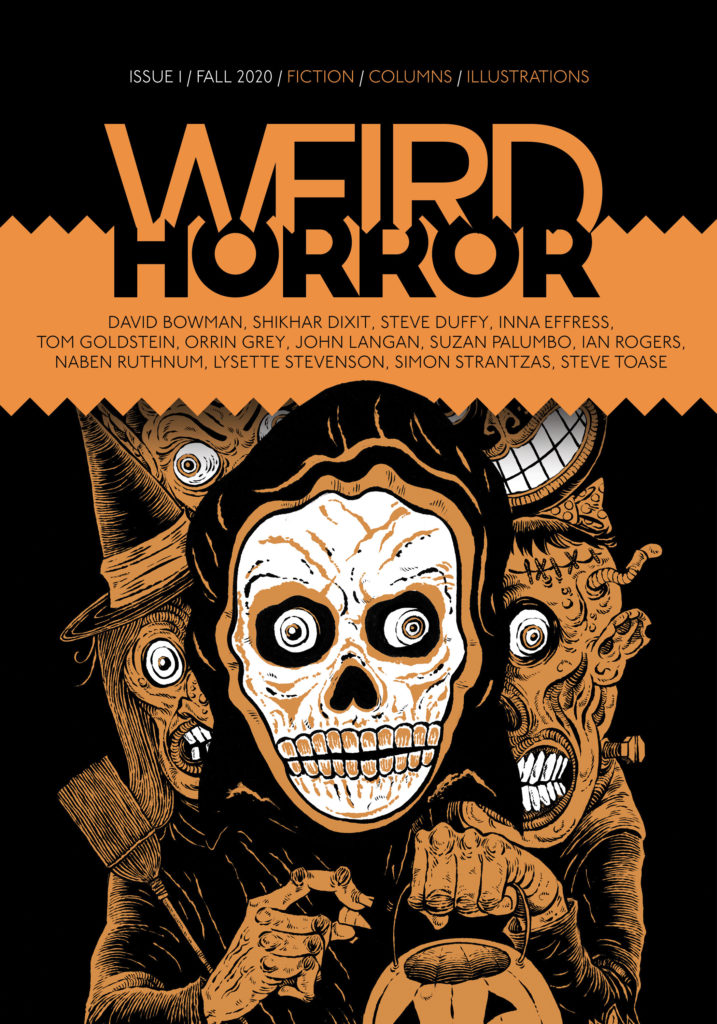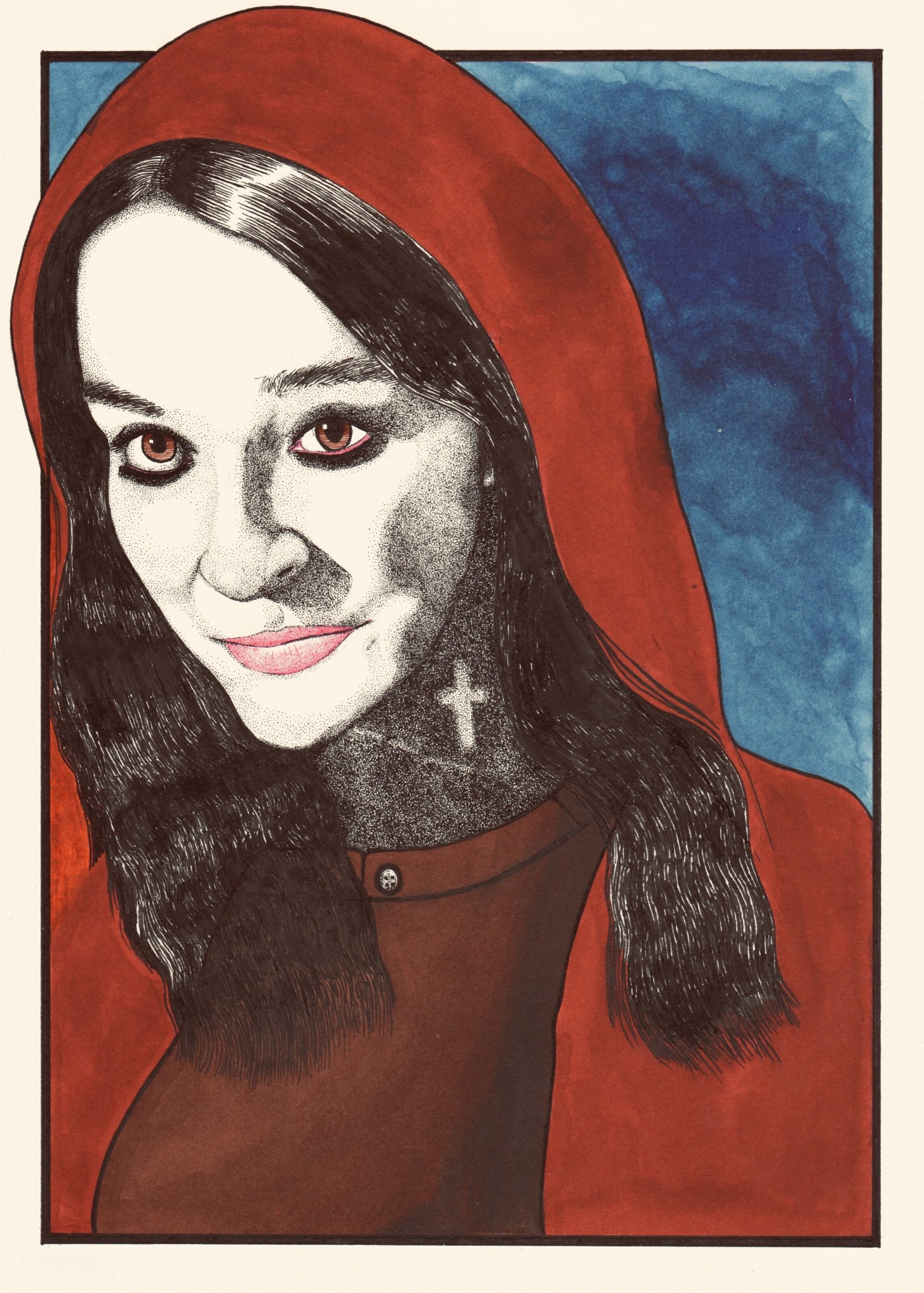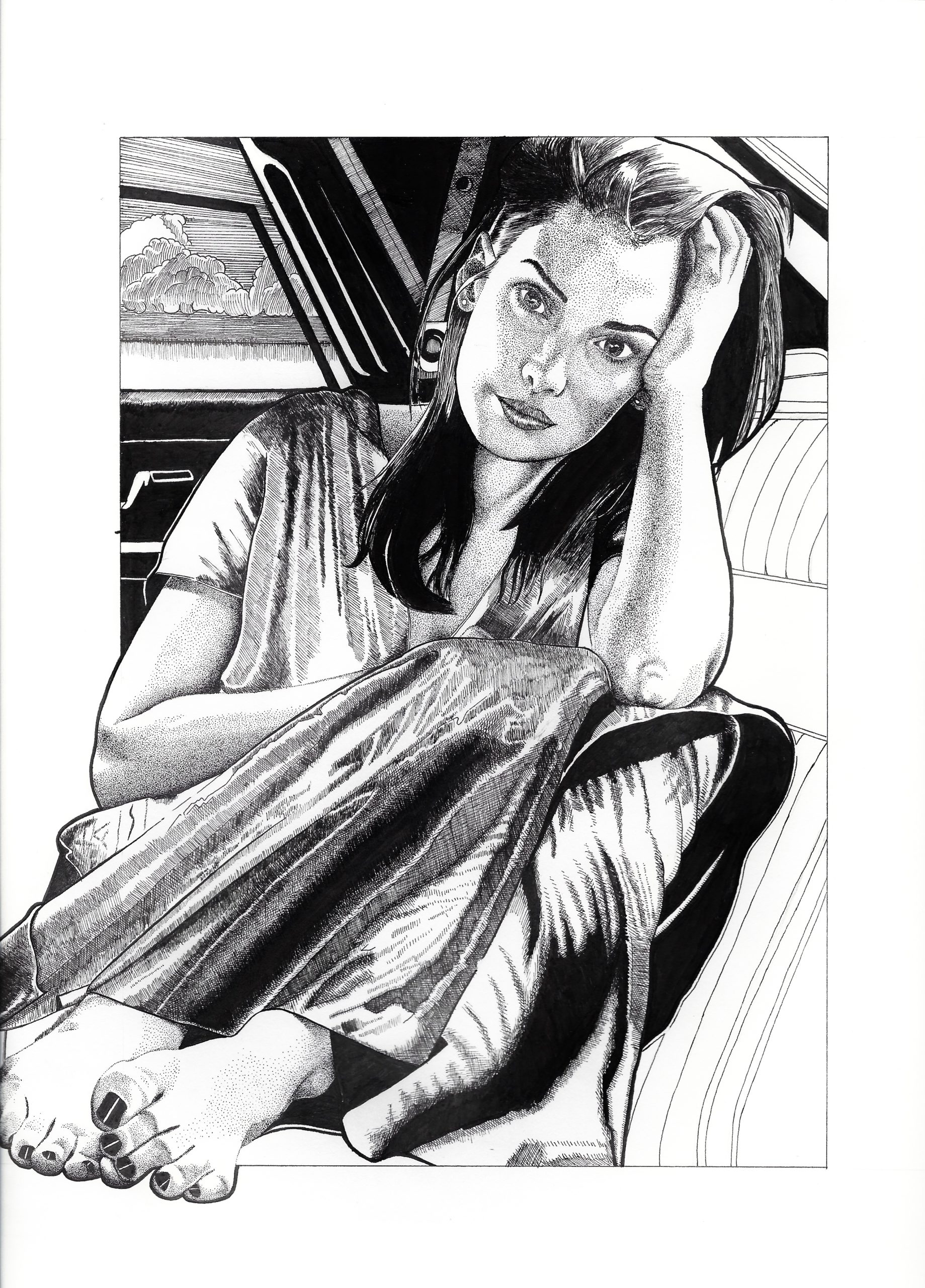My illustration for “A Night Out,” by David Hammond, is available in the latest issue of Space & Time Magazine. The issue also has a brand-new Joe Ledger story by the inimitable Jonathan Maberry! And you can view the rest of the Table of Contents. Or hell, just order Space & Time #137 (Summer 2020) directly from Amazon!
Author Archives
Amazon Has Listed Weird Horror #1 For Preorder
Amazon has listed Undertow Publications’ Weird Horror #1. Why not guarantee that you receive a copy and preorder it? And if you’re asking yourself— “Why does Shikhar care about this weird whatever he’s going on about?”—it is because the amazingly talented list of contributors includes none other than John Langan, and I’m a fan, as I am a fan of Undertow Publications, the preeminent publisher of weird horror fiction in America. Continue reading
Review for Final Cuts
Review for Final Cuts on Amazon
Full review below.
Ellen Datlow’s recent anthology, Final Cuts: New Tales of Hollywood Horror and Other Spectacles, is a solid, wall-to-wall extravaganza surrounding film and tangentially related media such as television, documentaries, police video, and yes, shadow puppets. I’m only going to highlight my favorite stories, but it’s a matter of personal taste: every story in the anthology was engaging and well-executed. I highly recommend picking up Final Cuts. Not all anthologies are this reliably entertaining from cover-to-cover.
I’ll begin with this very strong first story. “Das Gesicht” by Dale Bailey is an atmospheric tale filled with dread, about a long lost film so blasphemous that the viewers screamed, fainted and in some cases, lost their sanity. The title’s literal translation is “The Face.”
A.C. Wise’s “Exhalation #10” centers around a videotape that captures a woman’s final dying moments, particularly her final breaths. Believed to be the work of a serial killer, Henry is tasked with listening to the sound track because of his unique talent: he can hear what the authorities can not. Wise expertly leads the unwitting reader from dark revelation to even darker ones.
In “Scream Queen” by Nathan Ballingrud, Alan interviews former B-movie actress Jennifer Drummond, who only made one movie but captured the hearts (and groins) of countless boys and young men. Jennifer starts out almost angelically polite, then changes to something darker. The revelations in this tale place it among the scariest stories in the anthology. Ballingrud’s southern voice, a hallmark of his work, takes us to a place beyond damned in this eerie and disturbing tale.
“Night of the Living” by Paul Cornell is an interesting variation on classic zombie films.
Laird Barron’s “The One We Tell Bad Children” is a historical horror in which parents leave their children alone in a cabin, deep in the untamed woodland of 18th century America, to face forces beyond comprehension. The eldest, nominally in charge, plays a silent film called “Ardor of the Damned.” As the children watch, numbed with horror, so the film also watches them, setting in motion all the terror that follows. It’s also interesting that the story takes place in an alternate version of America.
“Snuff in Six Scenes” by Richard Kadrey is very short. Read it; it packs one hell of a punch!
Definitely my favorite story in the anthology, Brian Hodge’s “Insanity Among Penguins,” is ostensibly about a rumored documentary by Werner Herzog (look him up, he’s interesting) called Todestriebe; most or all copies of the film have been destroyed, but there are rumors. Our protagonist happens to be obsessed with Todestriebe; it’s his ‘white whale.’ Having given up the search, assuming the rumors are BS, he is granted an opportunity to see the film by his video store owner. Read it! It’s a truly remarkable piece of fiction.
“Lords of the Matinee” by Stephen Graham Jones is a wonderfully funny romp…that segues into darker territories when you least expect it.
“Folie À Deux, or The Ticking Hourglass” is a truly international story by Pakistani writer Usman T. Malik. Two TV documentarians are dispatched to record a serial child murderer’s gruesome execution. Then things get weird. Thoroughly enjoyable but difficult to sum up in a few sentences.
“Cut Frame” by Gemma Files is constructed entirely from emails, book quotes, and a transcript of an interview, to explain the mysterious 50s B-movie actress Tamar Dusk and what happened I her. A dentist, of all people (one of a particular film’s financiers) tells everything he knows to a Toronto-based parapsychologist about Tamar and the filming of a movie called The Torc. Files is adept with this modern version of an epistolary tale.
The last fifth of Final Cuts is my second favorite of the tales contained therein, John Langan’s “Altered Beast, Altered Me.” A mid-list horror novelist acquires Dracula’s ring, worn by several actors when they inhabited the role — but it seems to be of far older lineage. A long story that ended far too soon.
So kudos to Ellen Datlow on another successful and nearly perfect anthology.
Unwritten
It’s got to have been 10 days since I last did any writing. The issue is pain.
Since about ‘17, the pain (see AGONY) has been steadily increasing in my hips, and two points on my lumbar spine (and my left ear—but that is another story) such that I cannot sit at my desk, lean into my work, without triggering a landslide of torment. Early-onset osteoarthritis.
I rely on my writing as treatment for my bipolar disorder (same with drawing) so 10 days without writing is destabilizing for me, rendering me, at first, as irritable (ask Sherry), then proceeding towards sadness, yielding to feelings of insecurity, outright anger, and finally to moderate-to-severe depression.
I am writing this on my iPhone, btw…
There are few real solutions: surgery, surgery, and surgery. As diabetic, I’m especially susceptible to coronavirus (haven’t left the homestead in a few weeks) and other infections.
I’ve heard many writers, great and small, say that they often (always?) feel that there is not enough time. Joyce Carol Oates, whose body of work could fill an old-fashioned phone booth, has stated that.
I’m a long way from done-for, and if I have to finish my novel on my IPhone, I will. But that presents its own problems….
A Writerly Family
I am not the only writer in my family. We Dixits are a rather literary and artistic bunch. My cousin Pooja had the following article published in Salute. Pooja has been a journalist for several decades and worked as staff writer, (and at times as editor) at Times of India (India’s equivalent of The New York Times.
Pooja’s daughter, Ananya, at the age of 17, has had an article tackling equally weighty issues in feminism on Livewire (sister publication to The Wire.)
Author Michael Rowe acquires new publisher
Michael Rowe, formerly with ChiZine Press, has acquired (or been acquired by) a new publisher: Open Road Media.
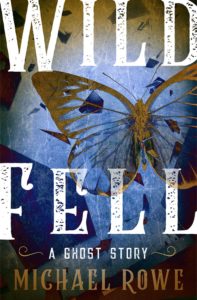
You can preorder his excellent novels: October, Enter, Night, and the Shirley Jackson Award
nominated Wild Fell, all at Amazon.
Coming Soonish…
The Story Behind the Most Difficult Story I’ve Ever Had to Write
In late 2003, I started a short story tentatively titled “The Clacker.” I had the bare bones of a religious concept, itself based on my bare bones knowledge about the Cathars, a branch of Christianity wiped out by the Roman Catholic Church. (If this behavior by the RCC comes as a surprise, you probably shouldn’t be reading horror fiction, or science fiction, or fantasy or…look, just pick up some history books from your local library. Concentrate on books aimed at young adults.) Of course, I had internet access, just like the vast majority of Americans. Usually, research plus imagination crystallizes into some kind of story! It isn’t necessarily a good story, but at least it has a middle and an ending, to keep the beginning company. After several hours in which I wrote, and rewrote (moved around some words) the same two or three paragraphs, I surrendered.
But this wasn’t exactly a surprise.
You see, my creativity had been slowly leaching away, like a vital nutrient washed out of the soil by heavy rains. Creativity is, perhaps, the most vital nutrient required in order for writers and illustrators to grow their respective works of art. I was both, so the losses were doubled.
Fast forward to 2013, when a fortuitous change in my medication started growing that essential creativity once more, and without warning. I found myself suddenly deluged, not by rain, but by The Nutrient. Potent stuff that the desire to create is, I was overwhelmed by ideas. Stories I wanted to write and drawings I wanted to do wouldn’t just materialize; I had to grow them. I had a LOT of work ahead of me. I did a bunch of drawings, mostly of women and elder gods, and stuttered through the beginnings of half-a-dozen stories that were essentially going nowhere. I was all over the place, writing horror, science fiction, dark fantasy…but just their opening paragraphs. Drawing came naturally to me. I’d been a visual artist first, having picked up crayons at approximately the age of five. I didn’t write my first story until high school—during senior year, no less. Writing required more focus.
I don’t remember how I got the idea to go looking through my old fiction folders, but it was the trigger, or the key, or even the electron microscope (focus, get it?)—choose your metaphor. I opened many old files, which my latest version of Microsoft Word needed to translate into the new century, second decade. I found myself aghast at such amateur writing, and absurd, old tropes from the 1990s. The only ones that held any promise were the seeds of classical material: ghosts, apocalypses, cosmic horror, Lovecraftiana (no, probably not a real word), etc. You get the picture.
Ultimately, I settled on two stories: the apocalyptic “Sacred Glyphs” and one of those Lovecraftian pieces, entitled “The Clackers.” First thing I did was rename it “The Bible Black,” a title I stole from Ronnie James Dio’s final project, Heaven and Hell. The fact that he died before the album’s release just gave this song a creepy pathos that no musician could, or would, be able to pay for. If you want to hear the song that would ultimately inspire “The God Whom No One Worships,” tap here.
To deflate this bloated blog post, I will hurry along, now. I asked both my wife, Sherry, and my good friend, author/artist Dean Italiano, to give it the metaphorical red-pen treatment. They both gave me a lot of good advice. I think it was around then that I renamed it “The God Whom No One Worships.” But as I read it over, again, I felt something was wrong. I was too close to it, though, had worked on it too recently, to be able to see it clearly.
So I hired Mary SanGiovanni’s MSEditing to help me improve that story, and it was worth every penny. When Michael Kelly was seeking a short work of pulp fiction, I sent, among other things, “The God Whom No One Worships.” He accepted, asking only that I retitle it “The Night Kingdom.”
So, “The Night Kingdom” (It just rolls off the tongue, doesn’t it? That’s why he wins the awards, folks.) will appear in the inaugural issue of Weird Horror #1, along with twelve other chilling tales, this October. I urge writers to pick it up in order to get an idea of what they’re looking for, and I urge everyone else to pick it up because it will undoubtedly be good spine-tingling fun.
My Review For…
Michael Rowe’s October
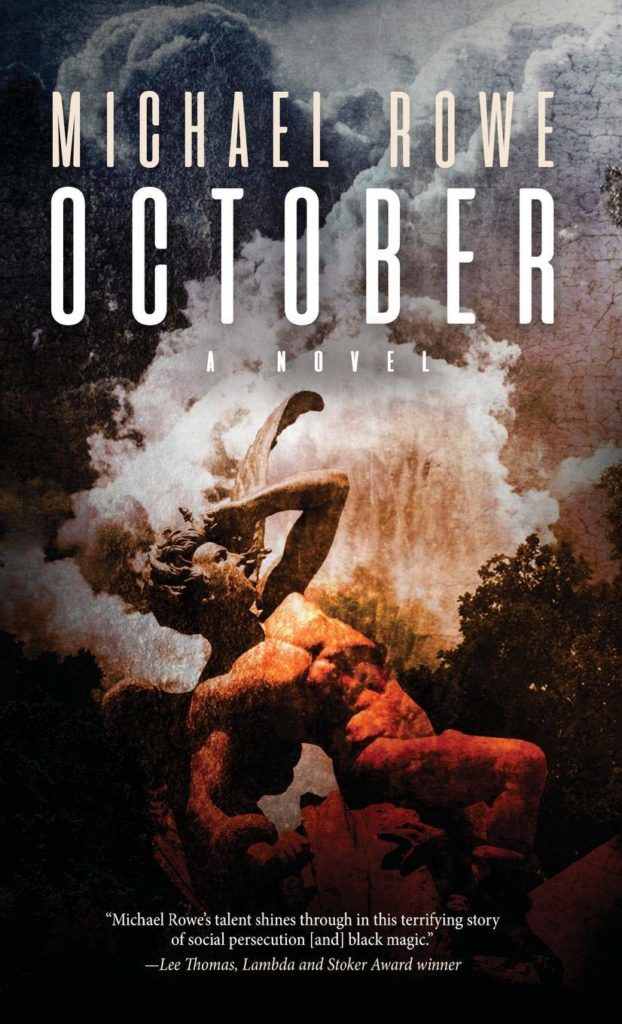
OCTOBER is, in many ways, the quintessential revenge novel. There is the sympathetic hero, Mikey Childress. There’s the girl, Wroxy. And there is the villain, Dewey Verbinski. And in this case, an idyllic setting, lovely Auburn, the town that tourists visit in autumn, when the changing leaves burn brightly with color. Where, legend has it, a coven of 12 witches practice dark magic on certain nights of the year.
But some key differences set OCTOBER apart. For example, Mikey is flamboyant, without quite admitting even to himself that he is gay. His entire school, it seems, as well as his own parents, and by extension the town of Auburn, don’t like him. During summer are his halcyon days. He spends that season alone, blissfully unabused, since he gets his joy from a vivid imagination, horror novels, horror films, and late night bike rides through the streets of Auburn.
Then September begins: enter the girl, a fiercely independent outcast, who also happens to be a witch. She’s there at school when Verbinski trips Mikey, embarrassing him in front of a cafeteria full of laughing students. Jim Fields, whose body he fantasizes about in the privacy of his room, watches as things go flying, and when Mikey’s CD Walkman comes sliding right to his feet, crushes it. After the incident, Wroxy approaches him. She’s just moved here from Vancouver, and finds Auburn to be a provincial hellhole. Once the two become acquainted, for the next three years they are inseparable best friends.
However, Dewey and Jim hatch a plan to get Mikey beaten up—an act that sets into motion a series of events where Mikey’s rage, unleashed, brings him into league with dark supernatural forces.
Rowe’s portrayal of a boy, on the cusp of manhood, and abused daily by his peers, is at once nerve-wracking and deeply saddening.
The supernatural horror aspect pales when contrasted with Mikey’s abuse, symbolic of what millions of young LGBTQIA children across the nations of Canada and the US have silently endured for decades. I highly recommend this novel to any and all members of the human race.

